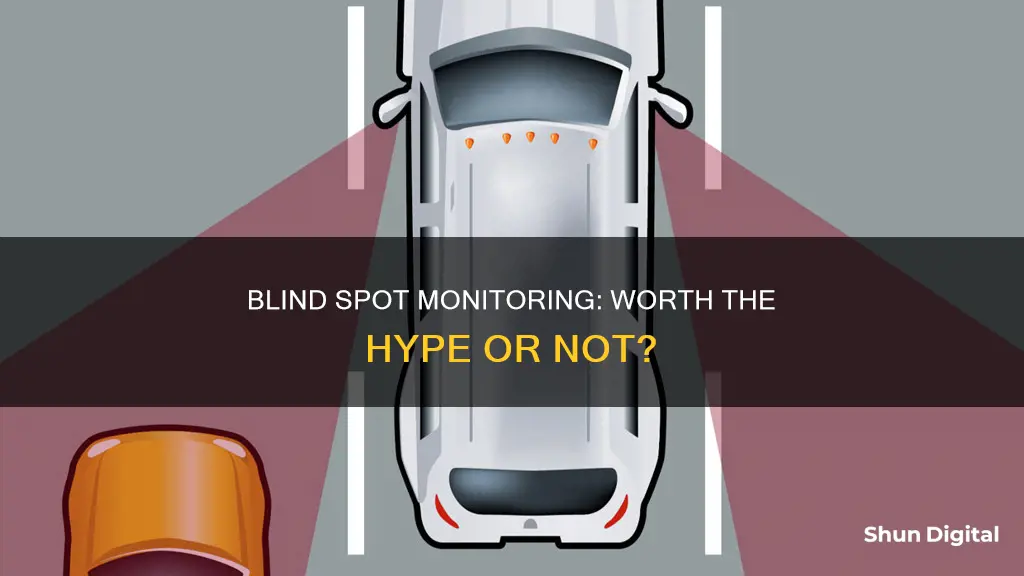
Blind-spot monitoring is a safety feature in vehicles that uses sensors, cameras, ultrasonic sensors, and radars to detect objects, vehicles, or people in the car's blind spot. It is designed to assist drivers in changing lanes or reversing and notify them of potential obstructions through visual, audible, or tactile alerts. While this technology is standard in higher-end vehicles, it is now offered as an optional extra in many affordable compact cars. This feature is especially useful for larger vehicles with bigger blind spots, such as SUVs, or when transporting children, as it provides an added layer of safety and helps prevent collisions. However, some critics argue that these systems can be overly sensitive, providing false warnings, and may not always be reliable in poor weather conditions.
| Characteristics | Values |
|---|---|
| What is it? | Blind-spot monitoring uses a set of sensors mounted on the side mirrors or rear bumper to detect vehicles in the adjacent lanes. |
| How does it work? | If the sensors detect something, they'll alert you via an audible and/or visual warning. Some vehicles use cameras as the main part of the system or to complement the sensors. |
| How much does it cost? | The cost of blind-spot monitoring varies depending on the make and model of the car. It can be included as standard or added for an extra fee. |
| Effectiveness | Blind-spot monitoring is one of the most useful tools for keeping drivers safe and reducing collisions. It can help minimise the risk of merging into another vehicle. |
| Limitations | Some studies suggest that blind-spot monitoring systems are too sensitive and can give false warnings. Bad weather can also affect the accuracy of the system's sensors. |
What You'll Learn

Blind-spot monitoring systems: how they work
Blind-spot monitoring systems are an effective driver assistance technology that can provide a full picture of a vehicle's surroundings, including objects, vehicles, or people in the car's way. These systems use a set of sensors, usually mounted on the side mirrors or rear bumper, to detect vehicles in adjacent lanes. If the system detects an object, it alerts the driver through audible, visual, or tactile warnings, such as a warning sound, a flashing light on the wing mirror, or a vibration on the steering wheel.
The effectiveness of blind-spot monitoring depends on the placement of the sensors and indicators. Sensors are typically lined up within the vehicle's structure, while indicators are placed on the side of the driver, often on the side mirrors or the A-pillar next to the window. The warnings can be customized to the driver's preferences and may include visual, audible, or tactile alerts, as well as vibrations.
In recent years, advancements have been made to enhance the functionality of blind-spot monitoring systems. Some systems now include a rear cross-traffic alert feature, which detects objects or pedestrians when reversing out of parking spots. Additionally, certain automakers have introduced systems that can detect attached trailers, making it easier to pull payloads. Another upgrade is the inclusion of collision prevention functionality, where the system can manipulate the steering and brakes to avoid a collision actively.
The cost of blind-spot monitoring technology has decreased over time, making it more accessible across the market. While it may not be necessary for all drivers or vehicle types, it can be particularly useful for larger vehicles with larger blind spots or for drivers who frequently transport passengers or children. Test-driving a vehicle equipped with blind-spot monitoring can help determine its value to individual drivers.
Calibrating Your LCD Monitor: Achieving Color Accuracy
You may want to see also

Cost of adding blind-spot monitoring to your car
The cost of adding blind-spot monitoring to your car varies depending on the type of system, the vehicle, and other factors.
Blind-spot monitoring systems can be purchased and installed on older vehicles that don't have them as standard. The cost of these systems can range from $100 to $750 or more, depending on various factors, including accuracy, range, and additional features.
The most basic systems, costing around $100 to $150, typically include a single radar sensor, a pair of indicator lights, and some accessories for installation. These systems may have a shorter alarm range and lower detection accuracy.
Mid-range systems, priced between $150 and $500, offer improved performance with features like additional sensors, better detection accuracy, and a wider alarm range.
Premium systems, costing $500 and above, provide highly accurate detection with advanced features such as cameras, internal controls, and high-end algorithms to prevent false triggers.
The type of vehicle also affects the cost, with truck systems typically being the most expensive, followed by car systems, while motorcycle systems are generally the least costly.
In addition to the system cost, there may be installation charges, typically ranging from $100 to $200, depending on the complexity of the installation process.
It is worth noting that some automakers include blind-spot monitoring as standard or offer it as part of a package with other safety features. However, in some cases, buyers might have to opt for higher trim levels or select specific packages to get blind-spot monitoring, which can add a significant cost to the vehicle's purchase price.
The Evolution of LCD Monitors: A Historical Perspective
You may want to see also

Blind-spot monitoring vs. driver shoulder checks
Blind-spot monitoring is a safety feature that uses sensors to detect vehicles, objects, or people in a car's adjacent lanes or way when reversing. The sensors are usually mounted on the side mirrors or rear bumper. When the sensors detect something, they alert the driver through audible, visual, or tactile warnings. This feature is now offered as standard or as an option across the market, not just on luxury vehicles.
On the other hand, shoulder checks are a traditional way of checking blind spots. They involve physically turning the head and looking over the shoulder to see what is in the blind spot. While this method can be effective, it can also be intimidating or overwhelming for new drivers, as it requires taking their eyes off the road, even if just for a second.
Both methods have their advantages and limitations. Blind-spot monitoring provides an additional layer of safety and convenience, especially for larger vehicles with bigger blind spots. It helps detect objects or vehicles that may be missed during a shoulder check. However, it may not always detect smaller vehicles like motorcycles or bicycles. Additionally, the system may have delays or malfunctions, so it is essential to remain vigilant and not rely solely on the technology.
Shoulder checks, on the other hand, provide a full picture of the surroundings and ensure that nothing is missed. They are a critical skill for drivers to master, as they allow for a direct view of the blind spot. However, shoulder checks can be challenging, especially for new drivers who may not know what they are looking for or how far to turn their heads. Additionally, taking the eyes off the road, even for a second, can be intimidating and may lead to missing critical information.
In conclusion, both blind-spot monitoring and shoulder checks have their merits. Blind-spot monitoring offers an advanced technological solution to enhance safety, while shoulder checks provide a traditional yet effective method of checking blind spots. Ideally, a combination of both methods should be employed for maximum safety. Drivers should utilize the technology available while also maintaining good driving habits, such as regular mirror checks and shoulder checks, to ensure a comprehensive awareness of their surroundings.
Monitor Size Guide: 40-Inch Displays' Dimensions Explained
You may want to see also

Effectiveness of blind-spot monitoring systems
Blind-spot monitoring systems are considered one of the most useful tools for road safety. They are especially helpful when changing lanes or turning, as they can detect vehicles, objects, or pedestrians in the car's blind spots. The systems use cameras, ultrasonic sensors, radars, and other means to detect obstacles and warn the driver through visual, audible, or tactile alerts. These warnings can include flashing lights on the side mirror, vibrations on the steering wheel, or beeps. The systems can also be customised to the driver's preferences.
The effectiveness of these systems is supported by studies. According to the Insurance Institute for Highway Safety (IIHS), an average of 350,000 deaths are caused by blind spots each year. Additionally, an IIHS study found that if all passenger vehicles were equipped with blind-spot monitoring, about one in three fatal crashes and one in five injury crashes could potentially be prevented or mitigated. This is a significant improvement in road safety.
However, some criticisms of blind-spot monitoring systems exist. Firstly, the systems may not always be accurate, with some studies showing that they can be too sensitive, giving false warnings. Bad weather conditions can also affect the accuracy of the sensors. Secondly, the constant alerts may become annoying for drivers, leading to alert fatigue and causing them to turn off the system.
Despite these limitations, blind-spot monitoring systems offer a valuable layer of protection on the road. They are particularly useful for larger vehicles with bigger blind spots, such as SUVs or vans, or when transporting passengers, especially children. Test-driving a vehicle with blind-spot monitoring can help determine its effectiveness for individual drivers.
Theatre Mode: ASUS Monitor's Unique Feature Explained
You may want to see also

Legality of blind-spot monitoring systems
Blind-spot monitoring is a vehicle-based sensor device that detects objects, vehicles, or people located to the driver's side and rear. This technology is equipped on vehicles to allow a 360° electronic coverage of the car. It uses cameras, ultrasonic sensors, radars, and other means to detect things outside the driver's field of vision.
While blind-spot monitoring is a useful safety feature, it is not mandatory. The government has not made blind-spot monitoring compulsory on all passenger cars, SUVs, and light trucks. However, some insurance companies may offer better rates or make it easier to get insurance if your vehicle has a blind-spot monitoring system installed.
The legality of blind-spot monitoring systems can vary depending on the region and specific regulations. In some places, there may be laws or guidelines regarding the use of such technology in vehicles. It is important to check the local laws and regulations to ensure compliance. Additionally, it is worth noting that while blind-spot monitoring can enhance safety, it does not replace the need for proper driver education and responsible driving habits.
When considering the legality of blind-spot monitoring systems, it is also essential to look at the potential risks and ethical implications. While these systems can provide valuable assistance to drivers, there may be concerns about overreliance on technology and the potential for malfunctions or errors. It is crucial to have regulations in place that ensure the proper testing, calibration, and maintenance of these systems to minimise risks and protect road users.
In summary, the legality of blind-spot monitoring systems can vary depending on the region and specific regulations. While it is not currently mandatory in some countries, it may be beneficial for enhancing safety and obtaining insurance. However, it is important to complement the use of such technology with proper driver education and responsible driving habits to ensure maximum safety on the roads.
HDMI Ports: Are They Standard on LCD Monitors?
You may want to see also
Frequently asked questions
Blind-spot monitoring uses sensors to detect vehicles in the adjacent lanes. The sensors are usually mounted on the side mirrors or the rear bumper. If the sensors detect something, they will alert the driver via an audible or visual warning.
Blind-spot monitoring is standard on some higher-end vehicles, but it can also be added as an optional extra on many affordable compact cars. The cost of a blind-spot monitoring (BSM) system depends on its features and accuracy. A BSM system for $250 or less will have limited monitoring capabilities, while a system for $500 or more will offer greater accuracy and brand options.
Blind-spot monitoring can improve safety and reduce the number of collisions on the road. According to a study by the IIHS, if all passenger vehicles were equipped with blind-spot monitoring, about 1 in 3 fatal crashes and 1 in 5 injury crashes could potentially be prevented or mitigated. Blind-spot monitoring is especially useful for larger vehicles with bigger blind spots, and when there are multiple drivers of a vehicle who may not adjust the mirrors correctly.
Some common complaints about blind-spot monitoring systems are that they can be overly sensitive and give false warnings, or that they don't understand double turning lanes. Additionally, bad weather can affect the accuracy of the system's sensors, causing drivers to ignore the warnings or turn them off completely.







